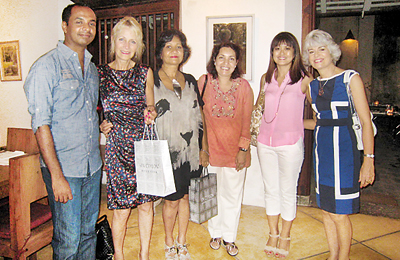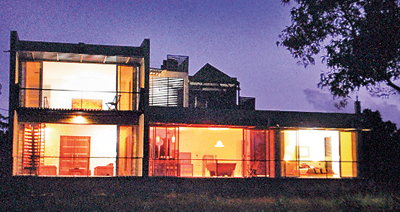A canvas of art and nature
The austere serenity, sweeping views, surprising vistas and intimate nooks and crannies of architect Geoffrey Bawa’s very private country estate on the Dedduwa Lake weave a spell on the visitor which is not easily forgotten. Could there be a more perfect place for a group of aspiring artists to spend a day testing and extending their skills by sketching and photographing for later work?

Anoma Wijewardene (third from left) with her group of students
The students of Anoma Wijewardene, internationally acclaimed artist, have had the privilege of such visits over the years as a result of the generosity and commitment to artistic endeavour of Sunethra Bandaranaike and the Geoffrey Bawa Trust.
The day in May of our visit begins early for me and my husband so as to catch the mist hanging over the river and the blueish tinge it gives to the hazy trees on the distant banks, for it will soon clear as the sun climbs higher.
There is a hush over the former rubber plantation once the dawn chorus is done, as Lunuganga’s wildlife goes about its business before the heat of the day. We explore unfrequented paths and discover trees and plants we have never seen before: a strange palm with the bark apparently eaten away and trees whose exposed roots and raised trunk make them look as if they have risen to dance. We examine the ancient, gnarled araliya trees by the bungalow, fascinated by the lichens and molds which grow on them.
When everyone has arrived, Anoma calls us together to fix the timing of our sessions, to comment on each other’s work and to eat lunch, then we all fan out to choose a first spot in which to sketch. Although there is some light cloud and rain is possible, the shadows become sharper and the glorious dappled effect of sunlight shining through the canopy of trees develops. Some gravitate to the approach to the bungalow’s paved courtyards with its interesting steps, or one of the lodges to explore Bawa’s blending of indoors and outdoors in his design, while others find one of the vantage points where he himself had loved to sit, and others descend to the lake or one of the water lily ponds.
I choose the ‘field of jars’ and set up in a shady spot which gives me a reflection of one of the Chinese jars in the pond and a view of several more. As I work away quietly I am aware that I am not alone. A squirrel is busy in a tree nearby and sometimes loudly proclaims its territory. On the other side of the pond a dark mongoose emerges from the shadows and darts across an open space. Later there is a hubbub in those trees as the branches are bent and shaken by a group of monkeys apparently arguing vociferously.
When Anoma strides into view to offer advice, she finds me deep in concentration, supremely relaxed and happy.
We meet by a columned lodge for lunch and spread out our work excitedly on a table. Everyone has discovered a different challenge, but all are inspired by this magical garden and the vision of this unusual man. Then we move to a new spot to start over again. By evening when we enjoy happy hour together on the lawn we are exhausted but pleased with our day’s work which will eventually result in this exhibition.
It comprises original work by five of us: Prameesha Abeysekera, Sharon Furkhan, Nihal Senarathne, Hema Udeshi and this writer, in a variety of media – pencil and charcoal drawings, watercolours, pastels, ink, mixed media, as well as prints of work by earlier students – and showcases each member of the group’s response to Bawa’s estate. The exhibition, which opened on Saturday, November 24 will run at The Gallery at The Fort Printers, Pedlar Street, Galle Fort until December 15.
Follow @timesonlinelk
comments powered by Disqus




























